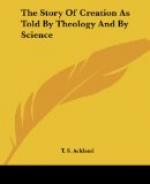CHAPTER IV.
Difficulties in physiology.
The third science which is supposed to come into collision with the Mosaic Record is Physiology. Here, however, we meet with no objections which rest upon ascertained facts, as in the case of geology. We have only to do with theories. All that can be brought forward is merely matter of opinion or theory—such theory resting indeed on a foundation of ascertained facts—but being in itself a mere inference more or less probable from those facts. Even if it were proved to be a true account of the causation of those facts, it would be by no means certain that other facts, however similar, might not have had a totally different origin.
At one time it was very confidently asserted, by many eminent physiologists, that the differences between various branches of the human race were so great, that it was impossible that all should have descended from the same original stock. Probably this opinion is still maintained in some quarters, but of late years views of a diametrically opposite character have been brought forward, and very ably advocated. In proportion as these views are admitted to have in them an element of truth, the importance of the older objection is diminished. It will therefore be unnecessary to dwell upon it. This new view is, that not only all branches of the human race, but all living beings now existing, or that have ever existed on the face of the earth, are descended by the process of “evolution,” carried on under what are designated as “natural laws” from some one variety, or small number of varieties of living creatures of the lowest type.
This theory, like that of Laplace, had its origin among the French Academicians, at the close of the last century. Its author was La Marck. According to his view the simplest form of animal life, the “monad,” was spontaneously developed by some unknown process. From this monad higher forms of animal life were produced, and the course of development was continued till it finally culminated in man. But it does not appear that La Marck suggested any means by which the various stages of development were brought about, and the view attracted little attention. Some thirty years ago it was revived by an anonymous writer, in a work called “Vestiges of Creation.” In this work the idea of spontaneous generation was repudiated. The original monad was supposed to have derived its existence from an act of Creative Power, and to have been then left to work out its own development, by virtue of powers originally implanted in it. All its variations and advances were supposed to be the result of the will and efforts of the creature acting through many generations. Thus the desire and attempt to walk ended in the development of legs, while wings were the final result of its efforts to fly. It was felt, however, that this was by no means a satisfactory account of the state of things, and so the work, though it produced a great sensation at the time, has now been almost entirely forgotten.




